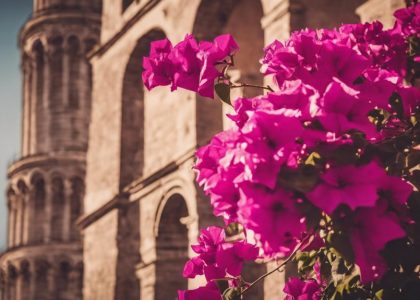Exploring the picturesque Orto Botanico di Pisa presents a unique opportunity for photographers seeking to capture the essence of nature through their lens. Amidst the lush greenery and vibrant botanical displays, mastering the art of utilizing natural light and choosing the optimal camera settings can elevate your images to new heights. However, there is a subtle yet crucial aspect that many overlook when aiming to portray the botanical diversity of this enchanting location. By focusing on enhancing your macro photography skills and effectively utilizing leading lines within the garden's intricate landscapes, you can unlock a world of stunning photo opportunities waiting to be captured.
Best Time for Natural Lighting

The optimal timing for capturing stunning photos at Orto Botanico Di Pisa is when the golden hour bathes the botanical gardens in warm, soft light, enhancing the natural beauty of the surroundings. As the sun begins to set, the soft golden light creates a magical atmosphere, casting a gentle glow over the vibrant greenery and colorful blooms of the garden. During this time, shadows are long and diffused, adding depth and dimension to your photos.
Photographers seeking freedom in their creative pursuits will find the golden hour at Orto Botanico Di Pisa to be the perfect opportunity to capture the essence of nature in its most enchanting form. The warm, golden light brings out the rich colors of the flowers and foliage, creating a stunning backdrop for your images. Whether you're a seasoned professional or an amateur enthusiast, taking advantage of this magical hour will ensure that your photos are imbued with a sense of beauty and tranquility that is truly captivating.
Ideal Camera Settings for Greenery

Selecting appropriate camera settings to capture the lush greenery at Orto Botanico Di Pisa requires attention to detail and precision in order to showcase the vibrant hues and intricate textures of the botanical landscape. To highlight the rich green tones and the fine details of the foliage, consider using a narrow aperture (higher f-stop number) to achieve a deep depth of field. This setting will ensure that both the foreground and background of your photos are sharply in focus, capturing the full beauty of the botanical garden. Additionally, adjusting the white balance to daylight or cloudy settings can enhance the natural colors of the greenery, making them appear more vivid and true to life. When it comes to shutter speed, a moderate setting can help prevent motion blur while allowing in sufficient light. Experimenting with these settings, along with utilizing a tripod for stability, will help you capture crisp and captivating images of the verdant landscapes at Orto Botanico Di Pisa.
Capturing the Botanical Diversity

How can photographers effectively showcase the diverse array of plant species at Orto Botanico Di Pisa through their lens? The Botanical Garden in Pisa offers a rich tapestry of plant life waiting to be captured in all its glory. To highlight this botanical diversity in your photographs, consider the following tips:
- Macro Photography: Zoom in on intricate details like the delicate veins of a leaf or the vibrant colors of a flower petal to reveal the beauty within the biodiversity of the garden.
- Wide Angle Shots: Capture the vast expanse of the garden to emphasize the variety of plants and trees coexisting in this botanical paradise.
- Close-ups of Unique Species: Seek out rare or unique plant species to showcase the distinctiveness of the botanical collection at Orto Botanico Di Pisa.
- Contrasting Textures: Play with the different textures present in the garden, juxtaposing smooth leaves against rough bark or shiny petals against a matte background to create visually compelling images that reflect the diverse botanical landscape.
Utilizing Leading Lines Effectively

To enhance the composition of botanical photographs taken at Orto Botanico Di Pisa, mastering the art of utilizing leading lines effectively can significantly elevate the visual impact of the images. Leading lines are a powerful compositional tool that guides the viewer's eye through the photo, creating a sense of depth and movement. In the lush botanical gardens of Orto Botanico Di Pisa, you can find various natural elements like pathways, branches, or streams that can serve as leading lines in your photos.
When composing your shot, look for these natural lines and use them to lead the viewer towards the main subject of your photograph. By strategically positioning these leading lines within the frame, you can create a sense of harmony and balance that adds interest and dimension to your botanical images. Experiment with different angles and perspectives to make the most of these leading lines and create captivating compositions that draw the viewer into the beauty of Orto Botanico Di Pisa.
Enhancing Macro Photography Skills

Developing an adept understanding of macro photography techniques is essential for capturing intricate details and magnifying the beauty of botanical subjects within the enchanting surroundings of Orto Botanico Di Pisa. To enhance your macro photography skills and create stunning botanical images, consider the following tips:
- Use a tripod: Stabilizing your camera on a tripod helps maintain sharp focus and prevents blurriness, especially when shooting tiny details up close.
- Adjust aperture settings: Experiment with different aperture settings to control the depth of field, allowing you to isolate the subject from the background or capture more of the botanical scene.
- Utilize natural light: Make the most of natural light to illuminate your subject naturally and enhance the colors and textures of the botanical elements.
- Get close and explore angles: Explore different angles and get as close as possible to capture unique perspectives and reveal the intricate patterns and textures of plants and flowers.





